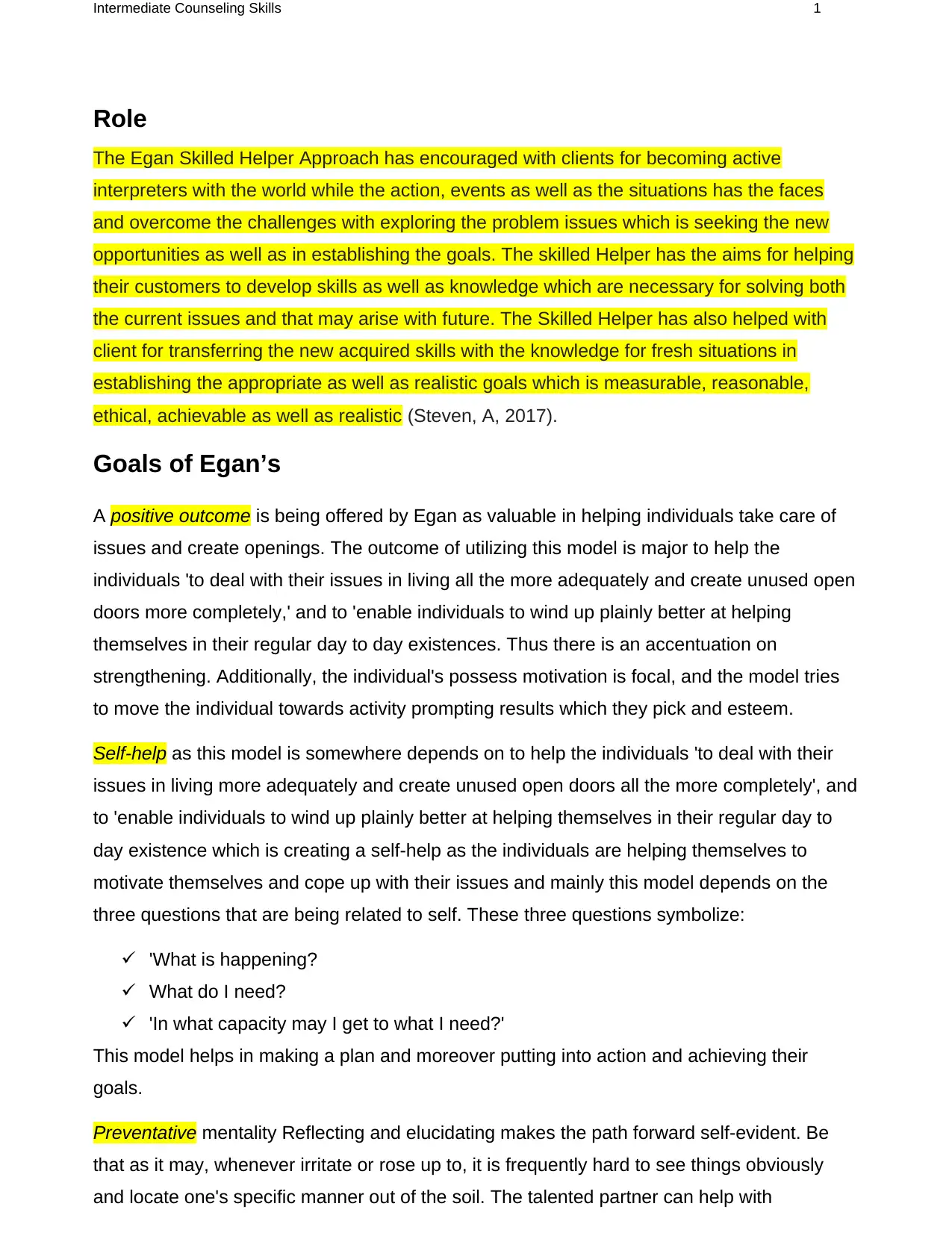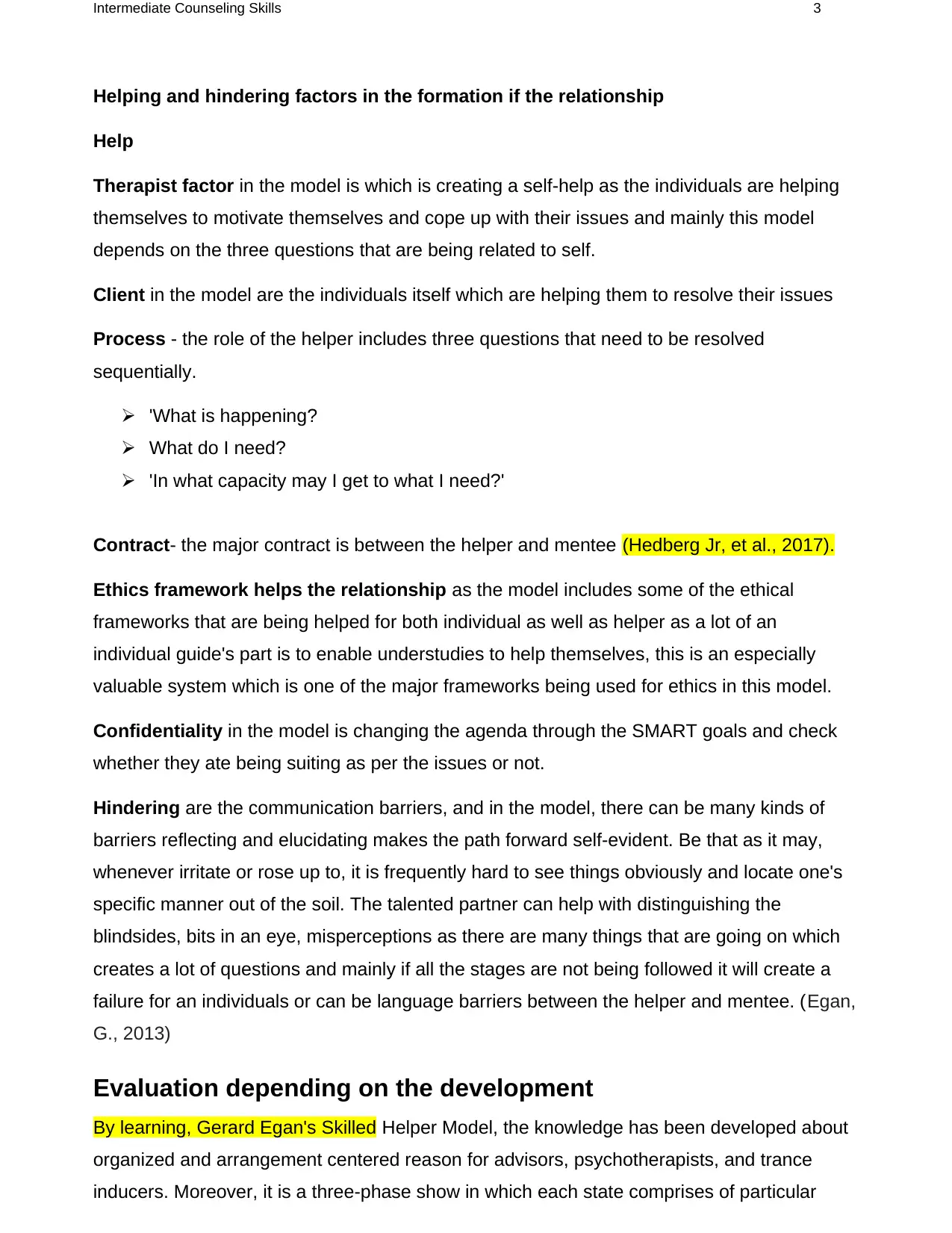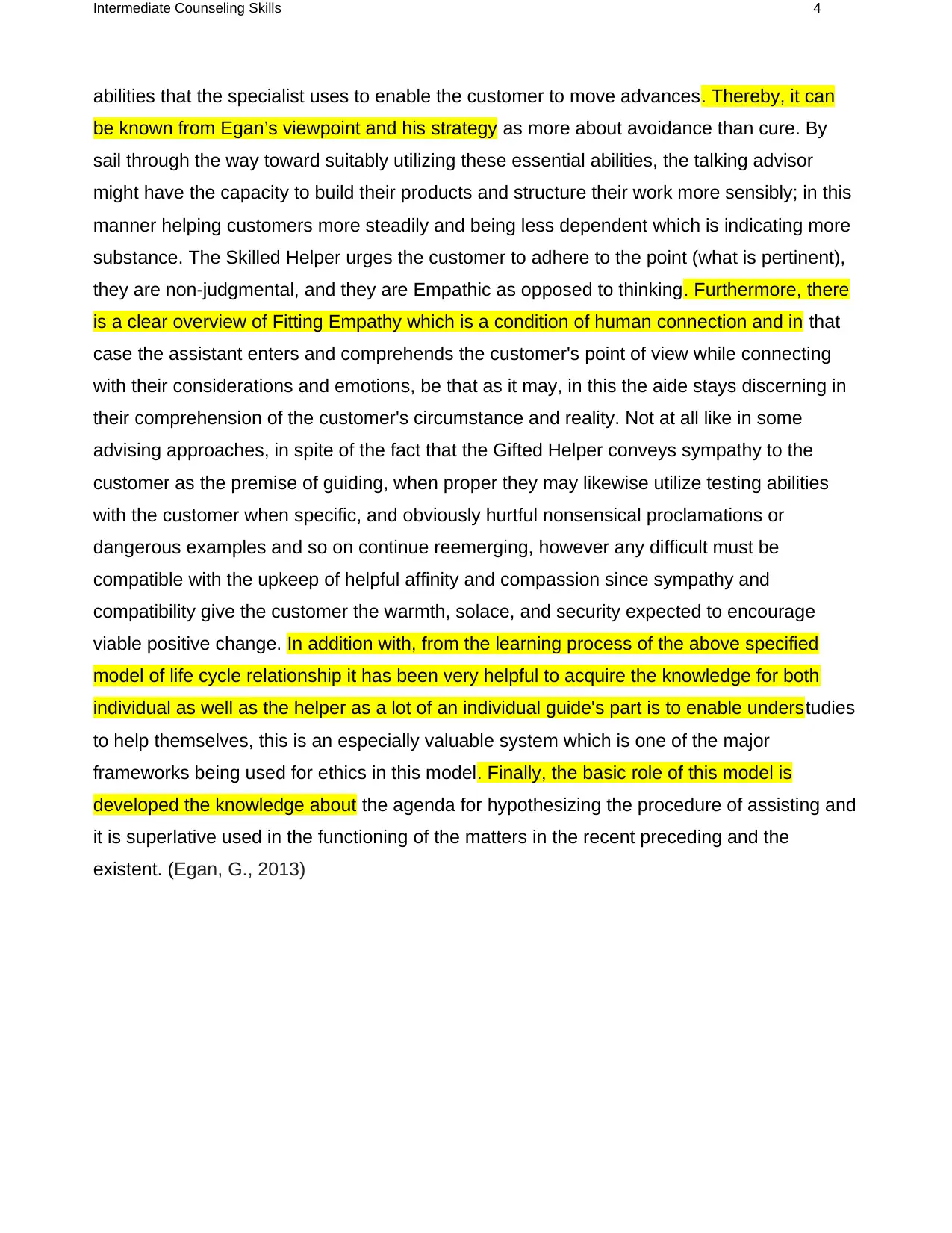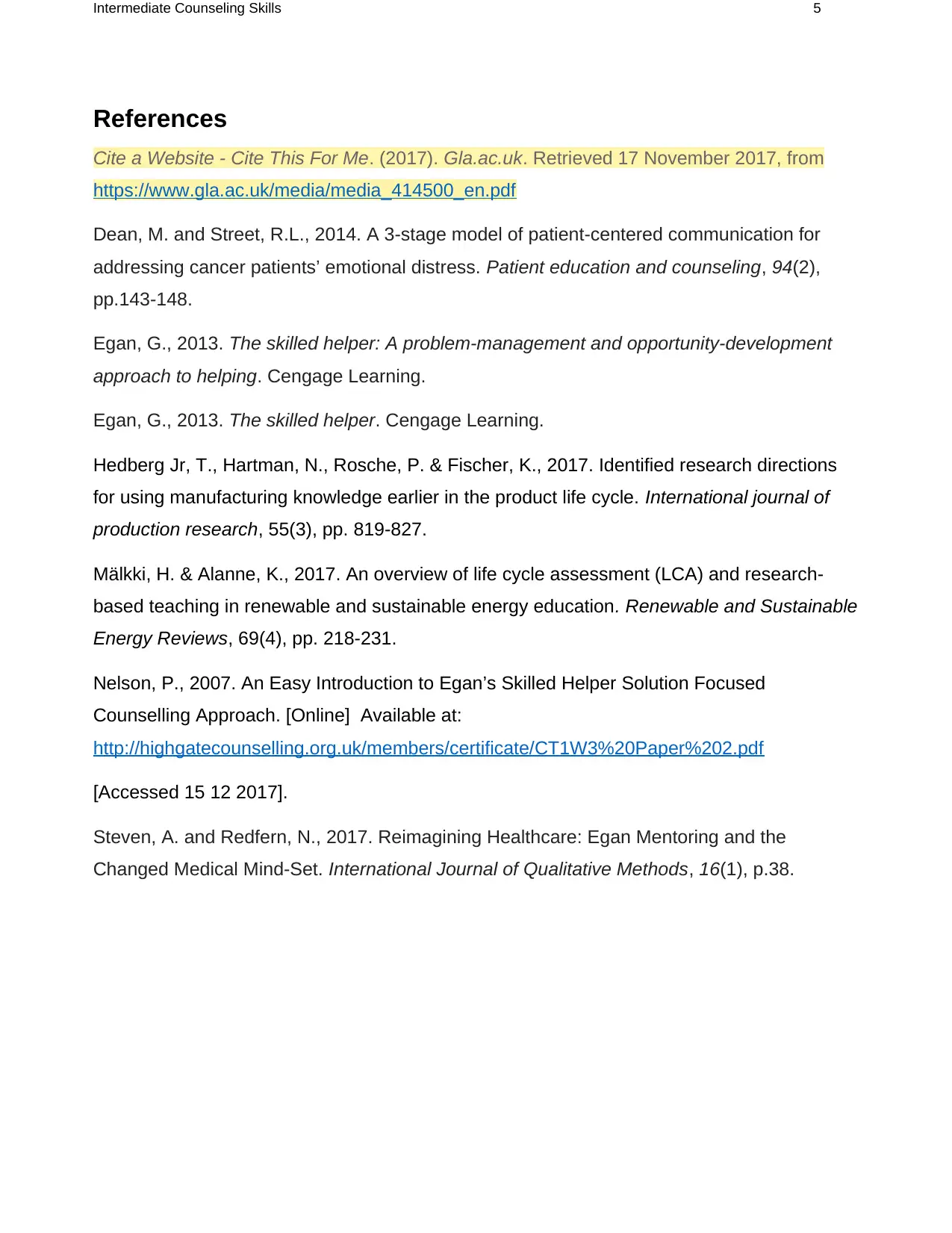Intermediate Counseling Skills: Egan's Skilled Helper Model Report
VerifiedAdded on 2019/09/20
|6
|1970
|396
Report
AI Summary
This report provides a comprehensive overview of Egan's Skilled Helper Model, a problem-management and opportunity-development approach used in counseling. It details the model's core principles, including its focus on empowering clients to solve current and future issues by acquiring necessary skills and knowledge. The report explores the three main stages of the model: exploration, challenging, and action planning, and their roles in helping clients achieve their goals. It also examines the life cycle relationship concept, helping and hindering factors in relationship formation, and the ethical frameworks that support the model, such as confidentiality and the use of SMART goals. The evaluation section highlights the benefits of the model in developing organized and structured counseling practices, promoting client self-help, and fostering empathy and non-judgmental support. References are also provided for further reading.

Intermediate Counseling Skills
Paraphrase This Document
Need a fresh take? Get an instant paraphrase of this document with our AI Paraphraser

Intermediate Counseling Skills 1
Role
The Egan Skilled Helper Approach has encouraged with clients for becoming active
interpreters with the world while the action, events as well as the situations has the faces
and overcome the challenges with exploring the problem issues which is seeking the new
opportunities as well as in establishing the goals. The skilled Helper has the aims for helping
their customers to develop skills as well as knowledge which are necessary for solving both
the current issues and that may arise with future. The Skilled Helper has also helped with
client for transferring the new acquired skills with the knowledge for fresh situations in
establishing the appropriate as well as realistic goals which is measurable, reasonable,
ethical, achievable as well as realistic (Steven, A, 2017).
Goals of Egan’s
A positive outcome is being offered by Egan as valuable in helping individuals take care of
issues and create openings. The outcome of utilizing this model is major to help the
individuals 'to deal with their issues in living all the more adequately and create unused open
doors more completely,' and to 'enable individuals to wind up plainly better at helping
themselves in their regular day to day existences. Thus there is an accentuation on
strengthening. Additionally, the individual's possess motivation is focal, and the model tries
to move the individual towards activity prompting results which they pick and esteem.
Self-help as this model is somewhere depends on to help the individuals 'to deal with their
issues in living more adequately and create unused open doors all the more completely', and
to 'enable individuals to wind up plainly better at helping themselves in their regular day to
day existence which is creating a self-help as the individuals are helping themselves to
motivate themselves and cope up with their issues and mainly this model depends on the
three questions that are being related to self. These three questions symbolize:
'What is happening?
What do I need?
'In what capacity may I get to what I need?'
This model helps in making a plan and moreover putting into action and achieving their
goals.
Preventative mentality Reflecting and elucidating makes the path forward self-evident. Be
that as it may, whenever irritate or rose up to, it is frequently hard to see things obviously
and locate one's specific manner out of the soil. The talented partner can help with
Role
The Egan Skilled Helper Approach has encouraged with clients for becoming active
interpreters with the world while the action, events as well as the situations has the faces
and overcome the challenges with exploring the problem issues which is seeking the new
opportunities as well as in establishing the goals. The skilled Helper has the aims for helping
their customers to develop skills as well as knowledge which are necessary for solving both
the current issues and that may arise with future. The Skilled Helper has also helped with
client for transferring the new acquired skills with the knowledge for fresh situations in
establishing the appropriate as well as realistic goals which is measurable, reasonable,
ethical, achievable as well as realistic (Steven, A, 2017).
Goals of Egan’s
A positive outcome is being offered by Egan as valuable in helping individuals take care of
issues and create openings. The outcome of utilizing this model is major to help the
individuals 'to deal with their issues in living all the more adequately and create unused open
doors more completely,' and to 'enable individuals to wind up plainly better at helping
themselves in their regular day to day existences. Thus there is an accentuation on
strengthening. Additionally, the individual's possess motivation is focal, and the model tries
to move the individual towards activity prompting results which they pick and esteem.
Self-help as this model is somewhere depends on to help the individuals 'to deal with their
issues in living more adequately and create unused open doors all the more completely', and
to 'enable individuals to wind up plainly better at helping themselves in their regular day to
day existence which is creating a self-help as the individuals are helping themselves to
motivate themselves and cope up with their issues and mainly this model depends on the
three questions that are being related to self. These three questions symbolize:
'What is happening?
What do I need?
'In what capacity may I get to what I need?'
This model helps in making a plan and moreover putting into action and achieving their
goals.
Preventative mentality Reflecting and elucidating makes the path forward self-evident. Be
that as it may, whenever irritate or rose up to, it is frequently hard to see things obviously
and locate one's specific manner out of the soil. The talented partner can help with

Intermediate Counseling Skills 2
distinguishing the blindsides, bits in an eye, misperceptions as there are many things that
are going on which creates a lot of questions and mainly if all the stages are not being
followed it will create a failure for individuals.
The three processes: Thus Egan’s Skilled Model consists of three processes or stages
which are described briefly here.
1. Exploration: At this stage mentor can know what is going on inside mentee’s and helping
him to explain that thinking without any judgement. The process includes positive body
language, eye contact, focusing on what is being told and what is the planning is going
on, the acceptancy as well as empathy.
2. Challenging: This process is encouraging the mentee with the thinking process whether
another way of judgment any issue.
3. Action Planning: There goal in turn has the possible way out for acquiring the results, it is
very important to help the mentee for setting realistic , achievable or practical targets
(Nelson, 2007).
Life cycle relationship
The life cycle relationship states that every relationship passes through different stages in
which individual face different situation. The life cycle relationship refers to a cycle or a
mechanism in which a relationship build, develop, reach to its maturity, decline, and then
ultimately ends. It means every relationship goes through different phases from start to the
ending of the relationship. The life cycle relationship states that every relationship ends.
When a relationship completes its life cycle or the natural life cycle the most appropriate
thing for the parties in the relationship to do is the end. Every relationship begins, reaches to
its middle or maturity and then ultimately end. Every relationship passes through several
stages such as early stage of the stage of romance, in which the parties in the relationship
enjoy their closeness and make every step of their life memorable, then the stage of struggle
comes in which differences of opinion arises due to which the parties of the relationship face
difficulties in their relationship, after the struggle stage the stage of stability comes in which
the parties in a relationship share mutual understanding and cooperate with each other to
have a strong relationship, next stage is commitment stage in which all the parties in the
relationship make commitment to fulfill the needs and wants of each other to have a strong
relationship. After the stage of commitment, the stage of conflict arises in which one of the
parties or all the parties start arguing with each other on every small mistake of any party. If
this stage is not sorted out the relationship reaches the stage of the end in which all the
parties mutually agree to be separate from each other (Mälkki & Alanne, 2017).
distinguishing the blindsides, bits in an eye, misperceptions as there are many things that
are going on which creates a lot of questions and mainly if all the stages are not being
followed it will create a failure for individuals.
The three processes: Thus Egan’s Skilled Model consists of three processes or stages
which are described briefly here.
1. Exploration: At this stage mentor can know what is going on inside mentee’s and helping
him to explain that thinking without any judgement. The process includes positive body
language, eye contact, focusing on what is being told and what is the planning is going
on, the acceptancy as well as empathy.
2. Challenging: This process is encouraging the mentee with the thinking process whether
another way of judgment any issue.
3. Action Planning: There goal in turn has the possible way out for acquiring the results, it is
very important to help the mentee for setting realistic , achievable or practical targets
(Nelson, 2007).
Life cycle relationship
The life cycle relationship states that every relationship passes through different stages in
which individual face different situation. The life cycle relationship refers to a cycle or a
mechanism in which a relationship build, develop, reach to its maturity, decline, and then
ultimately ends. It means every relationship goes through different phases from start to the
ending of the relationship. The life cycle relationship states that every relationship ends.
When a relationship completes its life cycle or the natural life cycle the most appropriate
thing for the parties in the relationship to do is the end. Every relationship begins, reaches to
its middle or maturity and then ultimately end. Every relationship passes through several
stages such as early stage of the stage of romance, in which the parties in the relationship
enjoy their closeness and make every step of their life memorable, then the stage of struggle
comes in which differences of opinion arises due to which the parties of the relationship face
difficulties in their relationship, after the struggle stage the stage of stability comes in which
the parties in a relationship share mutual understanding and cooperate with each other to
have a strong relationship, next stage is commitment stage in which all the parties in the
relationship make commitment to fulfill the needs and wants of each other to have a strong
relationship. After the stage of commitment, the stage of conflict arises in which one of the
parties or all the parties start arguing with each other on every small mistake of any party. If
this stage is not sorted out the relationship reaches the stage of the end in which all the
parties mutually agree to be separate from each other (Mälkki & Alanne, 2017).
⊘ This is a preview!⊘
Do you want full access?
Subscribe today to unlock all pages.

Trusted by 1+ million students worldwide

Intermediate Counseling Skills 3
Helping and hindering factors in the formation if the relationship
Help
Therapist factor in the model is which is creating a self-help as the individuals are helping
themselves to motivate themselves and cope up with their issues and mainly this model
depends on the three questions that are being related to self.
Client in the model are the individuals itself which are helping them to resolve their issues
Process - the role of the helper includes three questions that need to be resolved
sequentially.
'What is happening?
What do I need?
'In what capacity may I get to what I need?'
Contract- the major contract is between the helper and mentee (Hedberg Jr, et al., 2017).
Ethics framework helps the relationship as the model includes some of the ethical
frameworks that are being helped for both individual as well as helper as a lot of an
individual guide's part is to enable understudies to help themselves, this is an especially
valuable system which is one of the major frameworks being used for ethics in this model.
Confidentiality in the model is changing the agenda through the SMART goals and check
whether they ate being suiting as per the issues or not.
Hindering are the communication barriers, and in the model, there can be many kinds of
barriers reflecting and elucidating makes the path forward self-evident. Be that as it may,
whenever irritate or rose up to, it is frequently hard to see things obviously and locate one's
specific manner out of the soil. The talented partner can help with distinguishing the
blindsides, bits in an eye, misperceptions as there are many things that are going on which
creates a lot of questions and mainly if all the stages are not being followed it will create a
failure for an individuals or can be language barriers between the helper and mentee. (Egan,
G., 2013)
Evaluation depending on the development
By learning, Gerard Egan's Skilled Helper Model, the knowledge has been developed about
organized and arrangement centered reason for advisors, psychotherapists, and trance
inducers. Moreover, it is a three-phase show in which each state comprises of particular
Helping and hindering factors in the formation if the relationship
Help
Therapist factor in the model is which is creating a self-help as the individuals are helping
themselves to motivate themselves and cope up with their issues and mainly this model
depends on the three questions that are being related to self.
Client in the model are the individuals itself which are helping them to resolve their issues
Process - the role of the helper includes three questions that need to be resolved
sequentially.
'What is happening?
What do I need?
'In what capacity may I get to what I need?'
Contract- the major contract is between the helper and mentee (Hedberg Jr, et al., 2017).
Ethics framework helps the relationship as the model includes some of the ethical
frameworks that are being helped for both individual as well as helper as a lot of an
individual guide's part is to enable understudies to help themselves, this is an especially
valuable system which is one of the major frameworks being used for ethics in this model.
Confidentiality in the model is changing the agenda through the SMART goals and check
whether they ate being suiting as per the issues or not.
Hindering are the communication barriers, and in the model, there can be many kinds of
barriers reflecting and elucidating makes the path forward self-evident. Be that as it may,
whenever irritate or rose up to, it is frequently hard to see things obviously and locate one's
specific manner out of the soil. The talented partner can help with distinguishing the
blindsides, bits in an eye, misperceptions as there are many things that are going on which
creates a lot of questions and mainly if all the stages are not being followed it will create a
failure for an individuals or can be language barriers between the helper and mentee. (Egan,
G., 2013)
Evaluation depending on the development
By learning, Gerard Egan's Skilled Helper Model, the knowledge has been developed about
organized and arrangement centered reason for advisors, psychotherapists, and trance
inducers. Moreover, it is a three-phase show in which each state comprises of particular
Paraphrase This Document
Need a fresh take? Get an instant paraphrase of this document with our AI Paraphraser

Intermediate Counseling Skills 4
abilities that the specialist uses to enable the customer to move advances. Thereby, it can
be known from Egan’s viewpoint and his strategy as more about avoidance than cure. By
sail through the way toward suitably utilizing these essential abilities, the talking advisor
might have the capacity to build their products and structure their work more sensibly; in this
manner helping customers more steadily and being less dependent which is indicating more
substance. The Skilled Helper urges the customer to adhere to the point (what is pertinent),
they are non-judgmental, and they are Empathic as opposed to thinking. Furthermore, there
is a clear overview of Fitting Empathy which is a condition of human connection and in that
case the assistant enters and comprehends the customer's point of view while connecting
with their considerations and emotions, be that as it may, in this the aide stays discerning in
their comprehension of the customer's circumstance and reality. Not at all like in some
advising approaches, in spite of the fact that the Gifted Helper conveys sympathy to the
customer as the premise of guiding, when proper they may likewise utilize testing abilities
with the customer when specific, and obviously hurtful nonsensical proclamations or
dangerous examples and so on continue reemerging, however any difficult must be
compatible with the upkeep of helpful affinity and compassion since sympathy and
compatibility give the customer the warmth, solace, and security expected to encourage
viable positive change. In addition with, from the learning process of the above specified
model of life cycle relationship it has been very helpful to acquire the knowledge for both
individual as well as the helper as a lot of an individual guide's part is to enable understudies
to help themselves, this is an especially valuable system which is one of the major
frameworks being used for ethics in this model. Finally, the basic role of this model is
developed the knowledge about the agenda for hypothesizing the procedure of assisting and
it is superlative used in the functioning of the matters in the recent preceding and the
existent. (Egan, G., 2013)
abilities that the specialist uses to enable the customer to move advances. Thereby, it can
be known from Egan’s viewpoint and his strategy as more about avoidance than cure. By
sail through the way toward suitably utilizing these essential abilities, the talking advisor
might have the capacity to build their products and structure their work more sensibly; in this
manner helping customers more steadily and being less dependent which is indicating more
substance. The Skilled Helper urges the customer to adhere to the point (what is pertinent),
they are non-judgmental, and they are Empathic as opposed to thinking. Furthermore, there
is a clear overview of Fitting Empathy which is a condition of human connection and in that
case the assistant enters and comprehends the customer's point of view while connecting
with their considerations and emotions, be that as it may, in this the aide stays discerning in
their comprehension of the customer's circumstance and reality. Not at all like in some
advising approaches, in spite of the fact that the Gifted Helper conveys sympathy to the
customer as the premise of guiding, when proper they may likewise utilize testing abilities
with the customer when specific, and obviously hurtful nonsensical proclamations or
dangerous examples and so on continue reemerging, however any difficult must be
compatible with the upkeep of helpful affinity and compassion since sympathy and
compatibility give the customer the warmth, solace, and security expected to encourage
viable positive change. In addition with, from the learning process of the above specified
model of life cycle relationship it has been very helpful to acquire the knowledge for both
individual as well as the helper as a lot of an individual guide's part is to enable understudies
to help themselves, this is an especially valuable system which is one of the major
frameworks being used for ethics in this model. Finally, the basic role of this model is
developed the knowledge about the agenda for hypothesizing the procedure of assisting and
it is superlative used in the functioning of the matters in the recent preceding and the
existent. (Egan, G., 2013)

Intermediate Counseling Skills 5
References
Cite a Website - Cite This For Me. (2017). Gla.ac.uk. Retrieved 17 November 2017, from
https://www.gla.ac.uk/media/media_414500_en.pdf
Dean, M. and Street, R.L., 2014. A 3-stage model of patient-centered communication for
addressing cancer patients’ emotional distress. Patient education and counseling, 94(2),
pp.143-148.
Egan, G., 2013. The skilled helper: A problem-management and opportunity-development
approach to helping. Cengage Learning.
Egan, G., 2013. The skilled helper. Cengage Learning.
Hedberg Jr, T., Hartman, N., Rosche, P. & Fischer, K., 2017. Identified research directions
for using manufacturing knowledge earlier in the product life cycle. International journal of
production research, 55(3), pp. 819-827.
Mälkki, H. & Alanne, K., 2017. An overview of life cycle assessment (LCA) and research-
based teaching in renewable and sustainable energy education. Renewable and Sustainable
Energy Reviews, 69(4), pp. 218-231.
Nelson, P., 2007. An Easy Introduction to Egan’s Skilled Helper Solution Focused
Counselling Approach. [Online] Available at:
http://highgatecounselling.org.uk/members/certificate/CT1W3%20Paper%202.pdf
[Accessed 15 12 2017].
Steven, A. and Redfern, N., 2017. Reimagining Healthcare: Egan Mentoring and the
Changed Medical Mind-Set. International Journal of Qualitative Methods, 16(1), p.38.
References
Cite a Website - Cite This For Me. (2017). Gla.ac.uk. Retrieved 17 November 2017, from
https://www.gla.ac.uk/media/media_414500_en.pdf
Dean, M. and Street, R.L., 2014. A 3-stage model of patient-centered communication for
addressing cancer patients’ emotional distress. Patient education and counseling, 94(2),
pp.143-148.
Egan, G., 2013. The skilled helper: A problem-management and opportunity-development
approach to helping. Cengage Learning.
Egan, G., 2013. The skilled helper. Cengage Learning.
Hedberg Jr, T., Hartman, N., Rosche, P. & Fischer, K., 2017. Identified research directions
for using manufacturing knowledge earlier in the product life cycle. International journal of
production research, 55(3), pp. 819-827.
Mälkki, H. & Alanne, K., 2017. An overview of life cycle assessment (LCA) and research-
based teaching in renewable and sustainable energy education. Renewable and Sustainable
Energy Reviews, 69(4), pp. 218-231.
Nelson, P., 2007. An Easy Introduction to Egan’s Skilled Helper Solution Focused
Counselling Approach. [Online] Available at:
http://highgatecounselling.org.uk/members/certificate/CT1W3%20Paper%202.pdf
[Accessed 15 12 2017].
Steven, A. and Redfern, N., 2017. Reimagining Healthcare: Egan Mentoring and the
Changed Medical Mind-Set. International Journal of Qualitative Methods, 16(1), p.38.
⊘ This is a preview!⊘
Do you want full access?
Subscribe today to unlock all pages.

Trusted by 1+ million students worldwide
1 out of 6
Related Documents
Your All-in-One AI-Powered Toolkit for Academic Success.
+13062052269
info@desklib.com
Available 24*7 on WhatsApp / Email
![[object Object]](/_next/static/media/star-bottom.7253800d.svg)
Unlock your academic potential
Copyright © 2020–2025 A2Z Services. All Rights Reserved. Developed and managed by ZUCOL.




